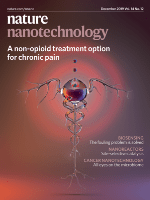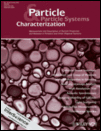
Nano Research
Scope & Guideline
Advancing the frontiers of nanoscience.
Introduction
Aims and Scopes
- Nanomaterials Synthesis and Characterization:
Research on novel methods for synthesizing nanomaterials, including chemical, physical, and biological approaches, alongside detailed characterization techniques to understand their properties. - Nanotechnology Applications in Engineering:
Exploration of how nanomaterials can be applied in engineering fields such as civil, mechanical, and materials engineering, focusing on their mechanical, thermal, and electrical properties. - Interdisciplinary Research in Nanotechnology:
Encouragement of cross-disciplinary studies that integrate nanotechnology with fields such as medicine, biology, and environmental science to address complex challenges. - Nanocomposite Materials:
Development and analysis of nanocomposite materials that incorporate nanoparticles to enhance the performance of traditional materials, focusing on their structural and functional properties. - Modeling and Simulation in Nanotechnology:
Utilization of computational methods and simulations to predict the behavior of nanomaterials and their interactions at the nanoscale, enhancing understanding and guiding experimental work.
Trending and Emerging
- Advanced Nanocomposite Applications:
An increasing focus on the development and application of advanced nanocomposites in various sectors, including construction, sports equipment, and electronics, indicating a trend towards practical, high-performance materials. - Machine Learning and AI in Nanotechnology:
Emerging studies that leverage machine learning and artificial intelligence for the design, optimization, and analysis of nanomaterials, highlighting a significant trend towards computational approaches in nanotechnology. - Sustainability and Eco-friendly Nanomaterials:
A rising interest in sustainable practices within nanotechnology, including the development of eco-friendly nanomaterials and processes, reflecting global trends towards environmental responsibility. - Biomedical Applications of Nanotechnology:
Significant growth in research focused on the biomedical applications of nanotechnology, including drug delivery systems, diagnostic tools, and therapeutic agents, showcasing the potential of nanomaterials in healthcare. - Smart and Functional Nanostructures:
Emerging research into smart materials that respond to environmental stimuli, integrating nanotechnology with sensors and actuators for innovative applications in various fields.
Declining or Waning
- Traditional Material Studies:
Research focused solely on conventional materials without integrating nanotechnology has seen a decrease, as the field increasingly emphasizes the unique advantages provided by nanomaterials. - Basic Nanotoxicity Studies:
While safety and toxicity of nanomaterials remain important, there has been a shift from basic toxicity studies to more applied research focusing on the implications of nanotoxicity in practical applications. - Single-Discipline Approaches:
The trend towards interdisciplinary research is leading to a decline in studies that focus exclusively on a single discipline, as the integration of multiple fields is becoming essential for advancing nanotechnology. - Static Analysis of Nanostructures:
Research focusing on static properties of nanostructures is declining in favor of dynamic analyses that consider the behavior of materials under various operational conditions.
Similar Journals

MATERIALS SCIENCE-POLAND
Exploring the Depths of Material InnovationMATERIALS SCIENCE-POLAND, published by SCIENDO, is an esteemed open access journal dedicated to the rapidly evolving field of materials science. Since its inception in 2002 and transitioning to an open access model in 2015, the journal has been a vital platform for researchers and professionals to disseminate their findings and contribute to the scientific community. With an ISSN of 2083-134X and an E-ISSN of 2083-134X, it spans a comprehensive range of disciplines, focusing on condensed matter physics, materials science, and mechanical engineering among others. In the 2023 rankings, it holds a position in the Q4 and Q3 quartiles across various categories, showcasing its relevance and ongoing contribution to these fields. Researchers benefit from its accessibility, enabling wider reach and engagement with contemporary topics in material innovation and applications. As the journal continues to evolve until 2024, it remains a cornerstone for scholars looking to advance their knowledge and research in materials science.

Physical and Chemical Aspects of the Study of Clusters Nanostructures and Nanomaterials
Transforming Nanoscience into Practical ApplicationsPhysical and Chemical Aspects of the Study of Clusters, Nanostructures, and Nanomaterials is an esteemed open-access journal published by TVER STATE UNIVERSITY, dedicated to advancing the scientific discourse surrounding the intricate interplay of physical and chemical properties in nanostructure materials. Launched in 2017, this journal provides a vital platform for researchers, professionals, and students to disseminate and access cutting-edge findings in the rapidly evolving fields of nanotechnology and materials science. With an ISSN of 2226-4442 and an E-ISSN of 2658-4360, it aims to bridge the gap between academic research and practical applications. By facilitating open access to high-quality research, the journal plays an essential role in promoting innovative solutions to contemporary challenges in engineering, materials development, and related industries. The journal's scope includes but is not limited to the synthesis, characterization, and functionalization of nanomaterials, ensuring comprehensive coverage of this multidisciplinary field.

International Journal of Nanoscience
Advancing Knowledge in Nano-Applications and BeyondThe International Journal of Nanoscience, published by WORLD SCIENTIFIC PUBL CO PTE LTD, stands as a significant platform in the multidisciplinary field of nanoscience and nanotechnology, offering a unique insight into innovative research developments and applications from 2004 to 2024. Based in Singapore, this journal provides an academic space for researchers, professionals, and students to explore the latest advancements across its wide-ranging scopes, which include bioengineering, biotechnology, computer science applications, condensed matter physics, electrical engineering, and materials science. While currently categorized in Q4 quartiles across multiple fields, the journal's commitment to quality research and scholarly discourse positions it as a pivotal resource for driving forward the understanding and application of nanoscience. Despite its non-open access format, the journal invites subscriptions from institutions and individuals eager to stay ahead in this rapidly evolving discipline. By fostering an environment of collaboration and innovation, the International Journal of Nanoscience aims to contribute significantly to the body of knowledge essential for future breakthroughs in science and technology.

Nature Nanotechnology
Elevating Knowledge in Nanotechnology and Beyond.Nature Nanotechnology, published by NATURE PORTFOLIO, stands at the forefront of scientific innovation, focusing on the rapidly evolving field of nanoscience and nanotechnology. With an impressive impact factor and ranking in the top Q1 quartiles across multiple disciplines—including Atomic and Molecular Physics, Bioengineering, and Materials Science—this journal is a pivotal resource for researchers and professionals dedicated to advancing knowledge and applications at the nanoscale. Its diverse scope encompasses cutting-edge research that bridges disciplines, addressing critical challenges in engineering, physics, and biomedical fields. Although the journal currently does not offer an open-access option, readers can access a wealth of information that is vital for anyone involved in pioneering research and development efforts. With its robust editorial standards and a commitment to publishing high-caliber, groundbreaking work, Nature Nanotechnology serves as an indispensable platform for the dissemination of transformative ideas that will shape the future of technology and science.

Nanoscience and Technology-An International Journal
Shaping the Future Through Nanoscience InsightsNanoscience and Technology-An International Journal, published by BEGELL HOUSE INC, is a leading platform dedicated to the rapidly evolving fields of nanoscience and nanotechnology. With its ISSN 2572-4258 and E-ISSN 2572-4266, the journal serves as a crucial resource for researchers, professionals, and students alike, focusing on advanced materials, condensed matter physics, and mechanics of materials. It holds a commendable position in the scholarly community, evidenced by its Q2 ranking in 2023 across multiple categories including Condensed Matter Physics and Materials Science. The journal aims to disseminate high-quality research, promote interdisciplinary collaboration, and facilitate innovation within the nano realm. With its convergence period from 2019 to 2024, it continues to attract a diverse array of studies and insightful contributions, reinforcing its importance in shaping the future of nanotechnology and its applications.

IRANIAN POLYMER JOURNAL
Exploring New Dimensions in Materials ChemistryWelcome to the Iranian Polymer Journal, an esteemed publication encompassing a rich history since its inception in 1996 and extending its scholarly reach up to 2024. Published by Springer from Switzerland, this journal stands out in the fields of Chemical Engineering, Materials Chemistry, and Polymers and Plastics, proudly holding a Q2 category ranking in each of these disciplines for 2023. With an ISSN of 1026-1265 and an E-ISSN of 1735-5265, the journal serves as a vital resource for researchers, professionals, and students, offering insights into polymer science and interdisciplinary applications. Although not an open-access journal, it presents an invaluable platform for high-quality research dissemination and robust peer-reviewed articles. With Scopus rankings indicating its respected position within the academic community, the Iranian Polymer Journal is committed to advancing knowledge and fostering innovation in polymer-related studies, making it an essential addition to your research library.

Discover Nano
Connecting Ideas, Shaping the Future of NanoscienceDiscover Nano is a pioneering journal published by SPRINGER, dedicated to the rapidly evolving field of nanoscience and nanotechnology. Established in 2023, this innovative platform provides an open-access forum for researchers, professionals, and students to share and disseminate cutting-edge findings in materials science and condensed matter physics. With its commitment to accessibility, Discover Nano encourages a broad spectrum of contributions, aiming to foster collaboration and stimulate discussion in this dynamic area of study. As a new entry into the academic community, the journal holds great potential for growth, aspiring to increase its visibility and impact in the materials science arena, where it currently ranks in the bottom quartile for both materials science and physics categories. Based in Germany and reaching a global audience, Discover Nano represents a significant opportunity for those looking to shape the future of nanotechnology through impactful research and interdisciplinary dialogue.

PARTICLE & PARTICLE SYSTEMS CHARACTERIZATION
Deepening Knowledge in Materials SciencePARTICLE & PARTICLE SYSTEMS CHARACTERIZATION is a distinguished journal dedicated to advancing the knowledge within the fields of Chemistry, Condensed Matter Physics, and Materials Science. Published by WILEY-V C H VERLAG GMBH in Germany, this journal has established a solid reputation since its inception in 1984, showcasing research aimed at understanding the intricate properties and behaviors of particulate systems. With an impressive Q2 ranking in its respective categories and Scopus ranks indicating a robust standing in the global research community, it serves as an essential resource for researchers, professionals, and students. Although it does not currently offer Open Access options, its comprehensive articles and reviews provide valuable insights that contribute significantly to the ongoing discourse in these scientific domains. As it prepares to celebrate four decades of publication, PARTICLE & PARTICLE SYSTEMS CHARACTERIZATION continues to provide a vital platform for emerging knowledge, fostering innovation and collaboration among scientists dedicated to the study of particle systems.

JOURNAL OF ELECTRONIC MATERIALS
Connecting Researchers to Groundbreaking Insights in ElectronicsWelcome to the Journal of Electronic Materials, a premier publication in the field of materials science. Published by Springer, this esteemed journal has been a beacon for groundbreaking research in electronic, optical, and magnetic materials since its inception in 1972. As an established resource, it boasts a commendable impact factor and categorically ranks in the second quartile (Q2) in key areas such as Condensed Matter Physics and Electrical and Electronic Engineering, as well as holding a respectable third quartile ranking in fields related to Electronic, Optical, and Magnetic Materials and Materials Chemistry. Researchers, professionals, and students can access a wealth of knowledge as we publish original articles, reviews, and cutting-edge research that push the boundaries of science and technology in these critical fields. Stay informed and engaged as we explore advancements that shape the future of electronic materials.

Carbon Trends
Empowering Scientists with Open Access InsightsCarbon Trends is a cutting-edge, openly accessible journal published by ELSEVIER, dedicated to advancing research and discussion in the domains of Chemistry, Materials Chemistry, and Materials Science. Established in 2020, this journal has quickly become a pivotal platform for scientists and researchers to share innovative findings related to carbon materials and their applications. With a solid impact factor and a ranking in the second quartile (Q2) across multiple subject categories, including a percentile standing in the top two-thirds of global publications, Carbon Trends plays an essential role in shaping the future of materials science. The journal’s open access model ensures that valuable research is accessible to a broad audience, facilitating collaboration and knowledge dissemination. Researchers, professionals, and students alike will benefit from the insights and trends published within its pages, guiding them in the rapidly evolving field of carbon sciences.